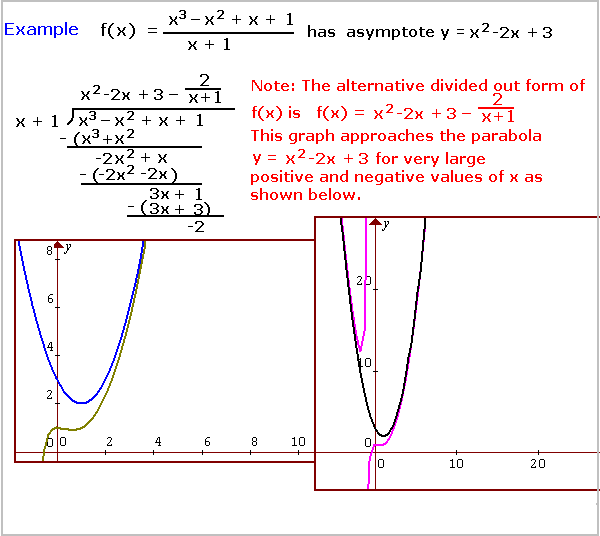Properties of Rational Functions
RF1 - Definition of a Reduced Rational Function:
If f(x) consists of a ratio of two polynomials P(x) and Q(x) where the
degree of Q(x) is at least 1, then f(x) is a Rational Function.
If P(x) and Q(x) contain no identical factors, the f(x) is a
Reduced Rational Function.



RF2 - Vertical Asymptotes: The vertical
asymptotes of a rational function in reduced form consist of
vertical lines of the form x=a where "a" is any
value of x resulting in division by zero.
As x-values of the rational function approach the vertical
asymptote value x=a from the right or the left, the y-value of the
function will increase to infinity or decrease to negative infinity.
RF3 - Horizontal Asymptotes: The horizontal
asymptote of a rational function in reduced or unreduced form
consists of a horizontal line of the form y=b where "b"
is the value of f(x) as x approaches positive or negative infinity.
For rational functions where the degree of the denominator is
greater than the degree of the numerator, y = 0 will be the horizontal
asymptote.

For rational functions of the form
 where m=n
where m=n
y = am/bn will be horizontal asymptote. In
other words, if the degrees of numerator and denominator are equal,
then the horizontal asymptote will consist of the horizontal line
equal to the ratio of the leading coefficients.

RF4 - Slant Asymptotes: The slant asymptote of
a rational function consists of a slanted line of the standard
linear form y=mx + b, m≠0,
where the graph of f(x) approaches this linear function as x
approaches positive or negative infinity.
The slant asymptote only occurs if the numerator is of degree one
more than the degree of the denominator. The slant asymptote may
be found by dividing the numerator of the rational function by the
denominator and rewriting the rational function as this result.
The slant asymptote will be equal to the non-fractional part of this
result.

RF5 - Higher Degree Asymptotes:
If the degree of the numerator is two or more greater than the
degree of the denominator, then there will be an asymptote of degree
equal to the difference in degrees. This higher degree asymptote
may be found by dividing the numerator of the rational function by the
denominator and rewriting the rational function as this result.
The higher degree asymptote will be equal to the non-fractional part
of this result.

|